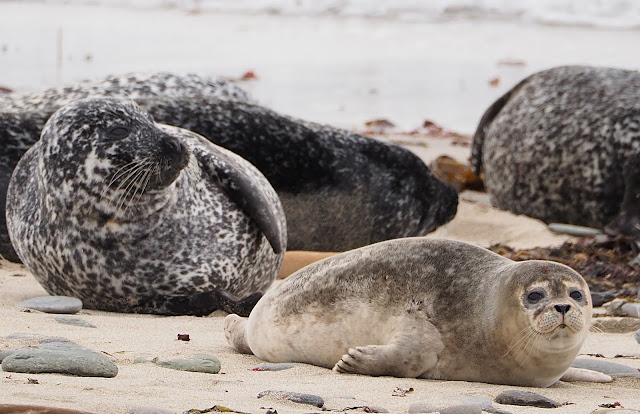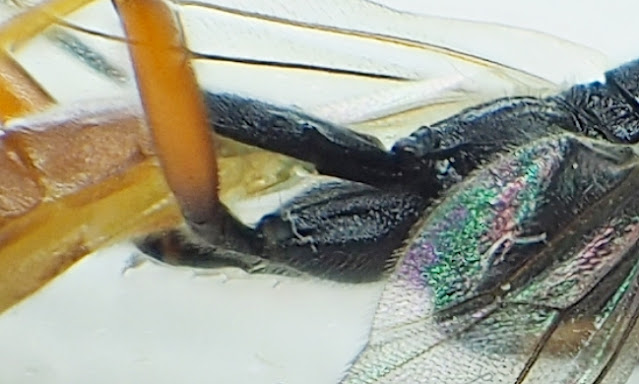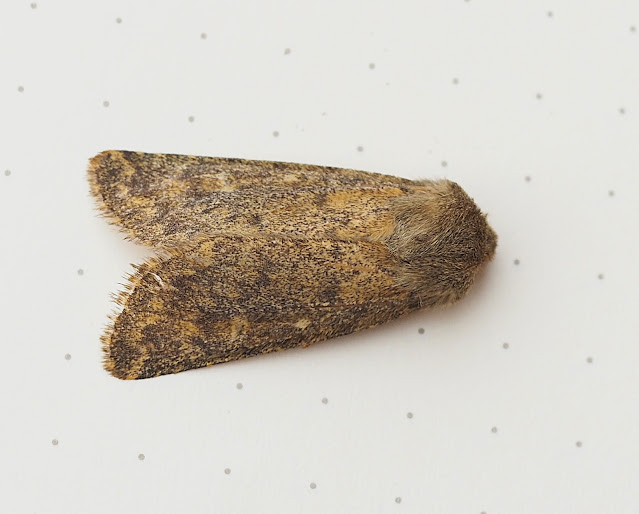It's been blowing easterly for a few days now, tricky for putting light traps out though as a lot of rain with the wind. I'd thought Friday and Saturday evenings would be good but gave Friday a miss as there was just too much rain (and I was busy with other things but more of that later), however, I put the synergetic Heath in a very sheltered spot by the back door against a wall on Saturday night. A Large Yellow Underwing, an Angleshades and a second Rusty-dot Pearl, following the one on 18/10/2022, were my reward.
 |
| Rusty-dot Pearl. |
Saturday had also produced a Hawfinch over the garden, flying low south and calling as I went to put apples on sticks out the back (what could I be hoping for?). Hawfinch call always gets me, huge, monster finch; thin, high-pitched call.
Orkney missed out on the massive thrush movement the other day but 54 Fieldfare yesterday, and 20 plus Redwings each day recently along with a smattering of Brambling and Blackbirds, mostly, have reminded me that autumn migration is occurring.
I knew it would rain a lot this morning but decided to put all three light traps out again last night. It was worth the effort, although I have a lot of egg cartons to dry on the Aga now. An Angleshades spent the night on the back wall and popping out at intervals to check that trap didn't produce anything more, except for craneflies which I'm not doing much with at the moment. I'd put the Robinson by the back wall with an actinic in it, good decision as I think Convolvulous Hawk might struggle to get inside the Heath traps.
 | |
| Convolvulous Hawk-moth, the third this autumn. |
 |
| Time to go. |
Also in the trap was a Brick and a Small Wainscot. I did check the Small Wainscot carefully, and ask for other opinions, as Blair's Wainscot is not dissimilar and is a very long shot in these migratory conditions.
 |
| Small Wainscot, thanks for checking BS and SS. |
 |
| Brick. I'd considered (hoped for) Yellow-line Quaker, but Brick it is. |
The actinic Heath at the front was empty, apart from a lot of pesky Diptera, particularly Scathophaga stercorarius, and the the synergetic at the back seemed to be the same, until on the last carton I found a Rush Veneer.
 |
| Rush Veneer, a migrant and NFS. |
I have found this species in Orkney previously, at Northside during the day, some years ago, but not at the home site and not in a trap. A good do all round. The Robinson, at least, will be going back out tonight.
On Friday evening there was a Field Club talk online. Louise was keen to attend and I also thought it seemed interesting, so we set it up in the living room. There were the usual technical shenanigans to start with, however, but Derek Pretswell got started pretty much on time. The talk can be found here: https://oisf.org/fest-event/new-life-for-the-land-and-wildlife-and-people/ or at least an earlier version of it. Derek challenges some preconceptions about tree growth and land management. I don't agree with everything he proposes, in particular I'm not keen on introducing alien species and I don't agree with excluding people from a very huge chunk of Scotland. But, there is a lot of very good thinking here, some fascinating biology. Politically I don't think the way forward as proposed will work, as I've stated elsewhere, small steps and finding common cause and common ground with political opponents strikes me as the only way, and that means some pragmatism. But this is powerful food for thought.
 |
| https://oisf.org/fest-event/new-life-for-the-land-and-wildlife-and-people/ |
Another Orkney Field Club connection was the "rice grains". There was a post on Orkney Insects Open Forum FB Group about case-bearing Coleophora moths being found on Juncus inflorescences. Previously, there had been a post on the Field Club FB pages and these sparked my interest as the moth wasn't identified. I did a bit of research and found the ID criteria via Vol 1 of Ben Smart's Micro-moth Field Tips. The full ID criteria are on the UK Moths web pages for the two confusion species Coleophora alticolella and Coleophora glaucicolella (scroll down to the bottom of each page for Ian J Smith's excellent images). Anyway, Saturday afternoon I toodled down to the fields by The Shunan which are full of Juncus (effusus I think). It took about a micro-second to find plants with the cases in the inflorescences, as nearly every plant had them, there are thousands of larvae in those fields. I'd been told the live larvae were hard to find, but I took ten or twelve cases and they all had live caterpillars in them.
 |
| Coleophora alticolella, annotated images, to aid splitting from C. glaucicolella. Thanks to UK Moths for the info. |
All the cases with caterpillars I examined were Coleophora alticolella, with the exception of one which might have been glaucicolella, but the caterpillar was slightly aberrant so I'll have to have another go to look for that species.
 |
| Coleophora alticolella, a new species for me. |
Anyway, the Robinson is out by the back door tonight and a few excursions outside have found Angleshades, again, and various moths flying.
 |
| This evening, from the garden. |





















































